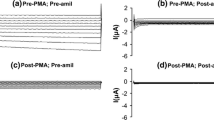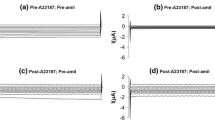Abstract
Effects of SH reagents on Cl− transport were studied in the isolated hamster thin ascending limb of Henle's loop (TAL) perfused in vitro. Parachloromercuribenzene sulfonate (PCMBS) at 10−4 M in the bath decreased the relative permeability for Cl−/Na+ (P Cl/P Na), as determined by the transmural diffusion voltage (V T) generated under a NaCl concentration gradient, from 2.71±0.16 to 1.11±0.09 (P<0.001). The effect of PCMBS was prevented by the pretreatment with 10−3 M dithiothreitol (DTT). N-Ethylmaleimide (NEM) at 10−3 M in the bath exhibited a dual action on Cl− permeability of the TAL: It inhibited the Cl− permeability in fresh preparations, whereas it stimulated the Cl− permeability in the preparations pretreated with SH reagents including NEM, maleimide and PCMBS. The inhibitory effect was irreversible but the stimulatory effect was reversible. Both responses were prevented by DTT. Since dextranmaleimide did not show any inhibitory effect onP Cl/P Na, the SH site responsible for the inhibition may be located inside of the cell. The stimulatory effect of NEM onP Cl/P Na was markedly reduced when bath pH was reduced to 5.8. On the other hand, when the bathing fluid was made nominally Ca2+ free, the stimulatory effect of NEM was unaffected, although the basal level ofP Cl/P Na was reduced. These observations suggest that the conductive Cl− pathway in the TAL is either stimulated or inhibited by modifying two distinct SH sites. The site of modulation by proton binding may exist distally to these SH sites. The regulatory mechanism involving Ca2+ may be independent of the SH regulatory sites.
Similar content being viewed by others
References
Abbott RE, Schachter D (1976) Impermeant maleimides. Identification of an exofacial component of the human erythrocyte hexose transport mechanism. J Biol Chem 251:7176–7183
Burg MB, Grantham J, Abramov M, Orloff J (1966) Preparation and study of fragments of single rabbit nephron. Am J Physiol 210:1293–1298
Ellman GL (1959) Tissue sulfhydryl groups. Arch Biochem Biophys 82:70–77
Hogg R, Kokko JP (1978) Comparison between the electrical potential profile and the chloride gradients in the thin limbs of Henle's loop in rats. Kidney Int 14:428–436
Imai M (1977) Function of the thin ascending limb of Henle of rats and hamsters perfused in vitro. Am J Physiol 232:F201-F209
Imai M (1984) Functional heterogeneity of the descending limbs of Henle's loop. II. Interspecies difference among rabbits, rats, and hamsters. Pflügers Arch 402:313–401
Imai M, Kokko JP (1974) Sodium, chloride, urea, and water transport in the thin ascending limb of Henle. Generation of osmotic gradients by passive diffusion of solutes. J Clin Invest 53:393–402
Imai M, Kokko JP (1976) Mechanism of sodium and chloride transport in the thin ascending limb of Henle. J Clin Invest 58:1089–1097
Imai M, Kusano E (1982) Effects of arginine vasopressin of the thin ascending limb of Henle's loop of hamsters. Am J Physiol 243:F167-F172
Imai M, Taniguchi J, Tabei K (1987) Function of thin loops of Henle. Kidney Int 31:565–579
Kondo Y, Imai M (1987) Selective inhibition of Cl− transport in the hamster thin ascending limb of Henle's loop. Pflügers Arch 408:484–490
Kondo Y, Yoshitomi K, Imai M (1987a) Effect of anion transport inhibitors and ion substitution on Cl− transport in the thin asceding limb of Henle's loop. Am J Physiol 253:F1206-F1215
Kondo Y, Yoshitomi K, Imai M (1987b) Effect of pH on Cl− transport in the thin ascending limb of Henle's loop. Am J Physiol 253:F1216-F1222
Kondo Y, Yoshitomi K, Imai M (1988) Effect of Ca2+ on Cl− transport in the thin ascending limb of Henle's loop. Am J Physiol (in press)
Marsh DJ, Martin CM (1977) Origin of electrical PD's in hamster thin ascending limbs of Henle's loop. Am J Physiol 232:F348-F357
Pearse AGE (1980) Histochemistry. Theoretical and applied, vol 1. Preparative and optical technology, 4th edn. Churchill Livingstone, Edinburgh London New York
Tauney PO, Snyder RH, Conger RP, Leibbrand KA, Stiteler CH, Williams AR (1961) The chemistry of maleimide and its derivatives. II. Maleimide and N-methylolmaleimide. J Org Chem 25:15–21
Author information
Authors and Affiliations
Rights and permissions
About this article
Cite this article
Imai, M., Kondo, Y., Koseki, C. et al. Dual effect of N-ethylmaleimide on Cl− transport across the thin ascending limb of Henle's loop. Pflugers Arch. 411, 520–528 (1988). https://doi.org/10.1007/BF00582373
Received:
Revised:
Accepted:
Issue Date:
DOI: https://doi.org/10.1007/BF00582373




